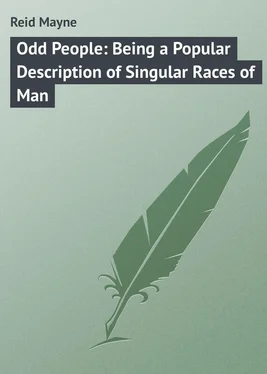Mayne Reid - Odd People - Being a Popular Description of Singular Races of Man
Здесь есть возможность читать онлайн «Mayne Reid - Odd People - Being a Popular Description of Singular Races of Man» — ознакомительный отрывок электронной книги совершенно бесплатно, а после прочтения отрывка купить полную версию. В некоторых случаях можно слушать аудио, скачать через торрент в формате fb2 и присутствует краткое содержание. Жанр: foreign_prose, на английском языке. Описание произведения, (предисловие) а так же отзывы посетителей доступны на портале библиотеки ЛибКат.
- Название:Odd People: Being a Popular Description of Singular Races of Man
- Автор:
- Жанр:
- Год:неизвестен
- ISBN:нет данных
- Рейтинг книги:4 / 5. Голосов: 1
-
Избранное:Добавить в избранное
- Отзывы:
-
Ваша оценка:
- 80
- 1
- 2
- 3
- 4
- 5
Odd People: Being a Popular Description of Singular Races of Man: краткое содержание, описание и аннотация
Предлагаем к чтению аннотацию, описание, краткое содержание или предисловие (зависит от того, что написал сам автор книги «Odd People: Being a Popular Description of Singular Races of Man»). Если вы не нашли необходимую информацию о книге — напишите в комментариях, мы постараемся отыскать её.
Odd People: Being a Popular Description of Singular Races of Man — читать онлайн ознакомительный отрывок
Ниже представлен текст книги, разбитый по страницам. Система сохранения места последней прочитанной страницы, позволяет с удобством читать онлайн бесплатно книгу «Odd People: Being a Popular Description of Singular Races of Man», без необходимости каждый раз заново искать на чём Вы остановились. Поставьте закладку, и сможете в любой момент перейти на страницу, на которой закончили чтение.
Интервал:
Закладка:
The Esquimaux people have been long known and their habits often described. Our first knowledge of them was obtained from Greenland, – for the native inhabitants of Greenland are true Esquimaux, – and hundreds of years ago accounts of them were given to the world by the Danish colonists and missionaries – and also by the whalers who visited the coasts of that inhospitable land. In later times they have been made familiar to us through the Arctic explorers and whale-fishers, who have traversed the labyrinth of icy islands that extend northward from the continent of America. The Esquimaux may boast of possessing the longest country in the world. In the first place, Greenland is theirs, and they are found along the western shores of Baffin’s Bay. In North America proper their territory commences at the straits of Belle Isle, which separate Newfoundland from Labrador, and thence extends all around the shore of the Arctic Ocean, not only to Behring’s Straits, but beyond these, around the Pacific coast of Russian America, as far south as the great mountain Saint Elias. Across Behring’s Straits they are found occupying a portion of the Asiatic coast, under the name of Tchutski, and some of the islands in the northern angle of the Pacific Ocean are also inhabited by these people, though under a different name. Furthermore, the numerous ice islands which lie between North America and the Pole are either inhabited or visited by Esquimaux to the highest point that discovery has yet reached.
There can be little doubt that the Laplanders of northern Europe, and the Samoyedes, and other littoral peoples dwelling along the Siberian shores, are kindred races of the Esquimaux; and taking this view of the question, it may be said that the latter possess all the line of coast of both continents facing northward; in other words, that their country extends around the globe – though it cannot be said (as is often boastingly declared of the British empire) that “the sun never sets upon it;” for, over the “empire” of the Esquimaux, the sun not only sets, but remains out of sight of it for months at a time.
It is not usual, however, to class the Laplanders and Asiatic Arctic people with the Esquimaux. There are some essential points of difference; and what is here said of the Esquimaux relates only to those who inhabit the northern coasts and islands of America, and to the native Greenlanders.
Notwithstanding the immense extent of territory thus designated, notwithstanding the sparseness of the Esquimaux population, and the vast distances by which one little tribe or community is separated from another, the absolute similarity in their habits, in their physical and intellectual conformation, and, above all, in their languages, proves incontestably that they are all originally of one and the same race.
Whatever, therefore, may be said of a “Schelling,” or native Greenlander, will be equally applicable to an Esquimaux of Labrador, to an Esquimaux of the Mackenzie River or Behring’s Straits, or we might add, to a Khadiak islander, or a Tuski of the opposite Asiatic coast; always taking into account such differences of costume, dialect, modes of life, etc, as may be brought about by the different circumstances in which they are placed. In all these things, however, they are wonderfully alike; their dresses, weapons, boats, houses, and house implements, being almost the same in material and construction from East Greenland to the Tchutskoi Noss.
If their country be the longest in the world, it is also the narrowest . Of course, if we take into account the large islands that thickly stud the Arctic Ocean, it may be deemed broad enough; but I am speaking rather of the territory which they possess on the continents. This may be regarded as a mere strip following the outline of the coast, and never extending beyond the distance of a day’s journey inland. Indeed, they only seek the interior in the few short weeks of summer, for the purpose of hunting the reindeer, the musk-ox, and other animals; after each excursion, returning again to the shores of the sea, where they have their winter-houses and more permanent home. They are, truly and emphatically, a littoral people, and it is to the sea they look for their principal means of support. But for this source of supply, they could not long continue to exist upon land altogether incapable of supplying the wants even of the most limited population.
The name Esquimaux – or, as it is sometimes written, “Eskimo,” – like many other national appellations, is of obscure origin. It is supposed to have been given to them by the Canadian voyageurs in the employ of the Hudson’s Bay Company, and derived from the words Ceux qui miaux (those who mew), in relation to their screaming like cats. But the etymology is, to say the least, suspicious . They generally call themselves “Inuit” (pronounced enn-oo-eet), a word which signifies “men;” – though different tribes of them have distinct tribal appellations.
In personal appearance they cannot be regarded as at all prepossessing – though some of the younger men and girls, when cleansed of the filth and grease with which their skin is habitually coated, are far from ill-looking. Their natural colour is not much darker than that of some of the southern nations of Europe – the Portuguese, for instance – and the young girls often have blooming cheeks, and a pleasing expression of countenance. Their faces are generally of a broad, roundish shape, the forehead and chin both narrow and receding, and the cheeks very prominent, though not angular. On the contrary, they are rather fat and round. This prominence of the cheeks gives to their nose the appearance of being low and flat; and individuals are often seen with such high cheeks, that a ruler laid from one to the other would not touch the bridge of the nose between them!
As they grow older their complexion becomes darker, perhaps from exposure to the climate. Very naturally, too, both men and women grow uglier, but especially the latter, some of whom in old age present such a hideous aspect, that the early Arctic explorers could not help characterising them as witches .
The average stature of the Esquimaux is far below that of European nations, though individuals are sometimes met with nearly six feet in height. These, however, are rare exceptions; and an Esquimaux of such proportions would be a giant among his people. The more common height is from four feet eight inches to five feet eight; and the women are still shorter, rarely attaining the standard of five feet. The shortness of both men and women appears to be a deficiency in length of limb, for their bodies are long enough; but, as the Esquimaux is almost constantly in his canoe, or “kayak,” or upon his dog-sledge, his legs have but little to do, and are consequently stunted in their development.
A similar peculiarity is presented by the Comanche, and other Indians of the prairies, and also in the Guachos and Patagonian Indians, of the South-American Pampas, who spend most of their time on the backs of their horses.
The Esquimaux have no religion, unless we dignify by that name a belief in witches, sorcerers, “Shamans,” and good or evil spirits, with, some confused notion of a good and bad place hereafter. Missionary zeal has been exerted among them almost in vain. They exhibit an apathetic indifference to the teachings of Christianity.
Neither have they any political organisation; and in this respect they differ essentially from most savages known, the lowest of whom have usually their chiefs and councils of elders. This absence of all government, however, is no proof of their being lower in the scale of civilisation than other savages; but, perhaps, rather the contrary, for the very idea of chiefdom, or government, is a presumption of the existence of vice among a people, and the necessity of coercion and repression. To one another these rude people are believed to act in the most honest manner; and it could be shown that such was likewise their behaviour towards strangers until they were corrupted by excessive temptation. All Arctic voyagers record instances of what they term petty theft, on the part of certain tribes of Esquimaux, – that is, the pilfering of nails, hatchets, pieces of iron-hoops, etc, – but it might be worth while reflecting that these articles are, in the eyes of the Esquimaux, what ingots of gold are are to Europeans, and worth while inquiring if a few bars of the last-mentioned metal were laid loosely and carelessly upon the pavements of London, how long they would be in changing their owners? Theft should be regarded along with the amount of temptation; and it appears even in these recorded cases that only a few of the Esquimaux took part in it. I apprehend that something more than a few Londoners would be found picking up the golden ingots. How many thieves have we among us, with no greater temptation than a cheap cotton kerchief? – more than a few, it is to be feared.
Читать дальшеИнтервал:
Закладка:
Похожие книги на «Odd People: Being a Popular Description of Singular Races of Man»
Представляем Вашему вниманию похожие книги на «Odd People: Being a Popular Description of Singular Races of Man» списком для выбора. Мы отобрали схожую по названию и смыслу литературу в надежде предоставить читателям больше вариантов отыскать новые, интересные, ещё непрочитанные произведения.
Обсуждение, отзывы о книге «Odd People: Being a Popular Description of Singular Races of Man» и просто собственные мнения читателей. Оставьте ваши комментарии, напишите, что Вы думаете о произведении, его смысле или главных героях. Укажите что конкретно понравилось, а что нет, и почему Вы так считаете.












